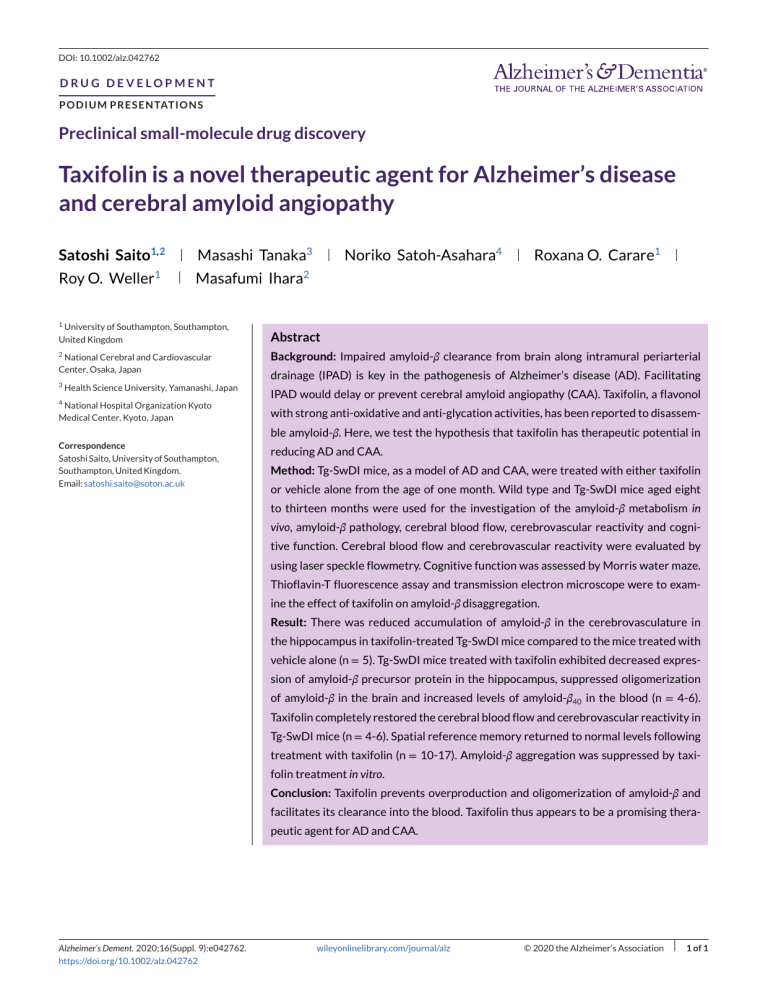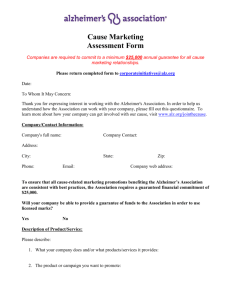
DOI: 10.1002/alz.042762 DRUG DEVELOPMENT PODIUM PRESENTATIONS Preclinical small-molecule drug discovery Taxifolin is a novel therapeutic agent for Alzheimer’s disease and cerebral amyloid angiopathy Satoshi Saito1,2 Masashi Tanaka3 Roy O. Weller1 Masafumi Ihara2 Noriko Satoh-Asahara4 Roxana O. Carare1 1 University of Southampton, Southampton, United Kingdom 2 National Cerebral and Cardiovascular Center, Osaka, Japan 3 Health Science University, Yamanashi, Japan 4 National Hospital Organization Kyoto Medical Center, Kyoto, Japan Abstract Background: Impaired amyloid-β clearance from brain along intramural periarterial drainage (IPAD) is key in the pathogenesis of Alzheimer’s disease (AD). Facilitating IPAD would delay or prevent cerebral amyloid angiopathy (CAA). Taxifolin, a flavonol with strong anti-oxidative and anti-glycation activities, has been reported to disassemble amyloid-β. Here, we test the hypothesis that taxifolin has therapeutic potential in Correspondence Satoshi Saito, University of Southampton, Southampton, United Kingdom. Email: satoshi.saito@soton.ac.uk reducing AD and CAA. Method: Tg-SwDI mice, as a model of AD and CAA, were treated with either taxifolin or vehicle alone from the age of one month. Wild type and Tg-SwDI mice aged eight to thirteen months were used for the investigation of the amyloid-β metabolism in vivo, amyloid-β pathology, cerebral blood flow, cerebrovascular reactivity and cognitive function. Cerebral blood flow and cerebrovascular reactivity were evaluated by using laser speckle flowmetry. Cognitive function was assessed by Morris water maze. Thioflavin-T fluorescence assay and transmission electron microscope were to examine the effect of taxifolin on amyloid-β disaggregation. Result: There was reduced accumulation of amyloid-β in the cerebrovasculature in the hippocampus in taxifolin-treated Tg-SwDI mice compared to the mice treated with vehicle alone (n = 5). Tg-SwDI mice treated with taxifolin exhibited decreased expression of amyloid-β precursor protein in the hippocampus, suppressed oligomerization of amyloid-β in the brain and increased levels of amyloid-β40 in the blood (n = 4-6). Taxifolin completely restored the cerebral blood flow and cerebrovascular reactivity in Tg-SwDI mice (n = 4-6). Spatial reference memory returned to normal levels following treatment with taxifolin (n = 10-17). Amyloid-β aggregation was suppressed by taxifolin treatment in vitro. Conclusion: Taxifolin prevents overproduction and oligomerization of amyloid-β and facilitates its clearance into the blood. Taxifolin thus appears to be a promising therapeutic agent for AD and CAA. Alzheimer’s Dement. 2020;16(Suppl. 9):e042762. https://doi.org/10.1002/alz.042762 wileyonlinelibrary.com/journal/alz © 2020 the Alzheimer’s Association 1 of 1





